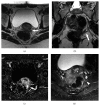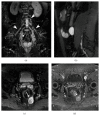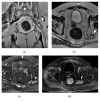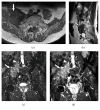Demystifying MR Neurography of the Lumbosacral Plexus: From Protocols to Pathologies
- PMID: 29662907
- PMCID: PMC5832061
- DOI: 10.1155/2018/9608947
Demystifying MR Neurography of the Lumbosacral Plexus: From Protocols to Pathologies
Abstract
Magnetic resonance neurography is a high-resolution imaging technique that allows evaluating different neurological pathologies in correlation to clinical and the electrophysiological data. The aim of this article is to present a review on the anatomy of the lumbosacral plexus nerves, along with imaging protocols, interpretation pitfalls, and most common pathologies that should be recognized by the radiologist: traumatic, iatrogenic, entrapment, tumoral, infectious, and inflammatory conditions. An extensive series of clinical and imaging cases is presented to illustrate key-points throughout the article.
Figures















References
Publication types
MeSH terms
LinkOut - more resources
Full Text Sources
Other Literature Sources
Medical

